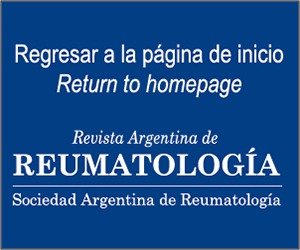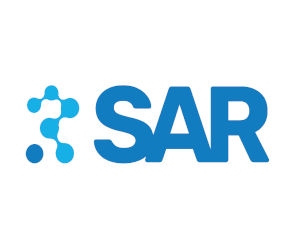Sobrevida, eficacia y seguridad de Golimumab en pacientes con Artritis Reumatoidea y Espondiloartritis: datos de una cohorte argentina
Resumen
Objetivos: golimumab ha sido aprobado para el tratamiento de pacientes con artritis reumatoidea (AR), artritis psoriásica (APs) y espondiloartritis axial. Sin embargo, los datos provenientes de nuestra región son escasos. El objetivo de este estudio fue evaluar la eficacia, seguridad y sobrevida acumulada de golimumab en pacientes de la vida real con AR, APs y espondilitis anquilosante (EA) de diferentes centros de Argentina. Material y métodos: se llevó a cabo un estudio longitudinal, en el que se incluyeron pacientes consecutivos mayores de 18 años con diagnóstico de AR (criterios ACR/EULAR 2010), APs (critertios CASPAR) y Espax (criterios ASAS 2009), que hayan iniciado tratamiento con golimumab de acuerdo a la indicación médica. Se obtuvieron los datos por revisión de historias clínicas. Se consignaron características sociodemográficas, clínicas, comorbilidades y tratamientos previos. Con respecto al golimumab, se registraron fecha de inicio, vía de administración y tratamientos concomitantes. Se determinó la actividad de la enfermedad mediante DAS28 en el caso de la AR, por DAPSA y MDA para APs y por BASDAI en el caso de Espax. Se consignó la presencia de eventos adversos (EA). En el caso de suspensión del tratamiento, se identificaron la fecha y motivo del mismo. Los pacientes fueron seguidos hasta la suspensión del golimumab, pérdida de seguimiento, muerte, o finalización del estudio (30 de noviembre de 2020). Resultados: se incluyeron 182 pacientes, 116 con diagnóstico de AR, 30 con APs y 36 con Espax. La mayoría de ellos (70.9%) eran mujeres con una edad mediana (m) de 55 años (RIC 43.8-64) y una duración de la enfermedad m de 7 años (RIC 4-12.7) al inicio del tratamiento. El 34.6% de los mismos habían recibido al menos una droga modificadora de la enfermedad (DME) biológica (-b) o sintética dirigida (-sd) previamente. El seguimiento total fue de 318.1 pacientes/año. El tratamiento con golimumab mostró mejoría clínica en los tres grupos de pacientes. La incidencia de eventos adversos fue de 6.6 por 100 pacientes/año, siendo las infecciones las más frecuentes. Durante el seguimiento, 50 pacientes (27.5%) suspendieron golimumab, la causa más frecuente fue el fracaso del tratamiento (68%), seguida de la falta de cobertura (16%) y el desarrollo de eventos adversos (10%). La persistencia de golimumab fue del 76% y 68% a los 12 y 24 meses, respectivamente. Se registró una sobrevida de 50.2 meses (IC 95% 44.4-55.9). Los pacientes que habían recibido tratamiento previo con DME-b y/o -sd mostraron una menor sobrevida (HR 2.4, IC 95% 1.3-4.4). Conclusiones: el tratamiento con golimumab en pacientes de la vida real en Argentina ha demostrado una buena eficacia y seguridad. La sobrevida del fármaco fue de más de 4 años y casi el 80% seguía usando golimumab después de un año. El tratamiento previo con otros DME-b o -sd se asoció con una menor sobrevida al tratamiento.Citas
I. Thompson C, Davies R, Choy E. Anti-cytokine therapy in chronic inflammatory arthritis. Cytokine. 2016;86:92-9.
II. Pincus T, Sokka T. Should contemporary rheumatoid arthritis clinical trials be more like standard patient care and vice versa? Ann Rheum Dis 2004;63 Suppl 2:ii32-ii39.
III. Cramer JA, Roy A, Burrell A, Fairchild CJ, Fuldeore MJ, Ollendorf DA, et al. Medication compliance and persistence: terminology and definitions. Value Health. 2008;11(1):44-7.
IV. Voulgari PV. Golimumab: a new anti-TNF-alpha agent for rheumatoid arthritis, psoriatic arthritis and ankylosing spondylitis. Expert Rev Clin Immunol. 2010;6(5):721-33.
V. Keystone EC, Genovese MC, Klareskog L, Hsia EC, Hall ST, Miranda PC, et al. Golimumab, a human antibody to tumour necrosis factor {alpha} given by monthly subcutaneous injections, in active rheumatoid arthritis despite methotrexate therapy: the GO-FORWARD Study. Ann Rheum Dis 2009;68(6):789-96.
VI. Smolen JS, Kay J, Doyle MK, Matteson EL, Wollenhaupt J, Gaylis N, et al. Golimumab in patients with active rheumatoid arthritis after treatment with tumour necrosis factor alpha inhibitors (GO-AFTER study): a multicentre, randomised, double-blind, placebo-controlled, phase III trial. Lancet 2009;374(9685):210-21.
VII. Kavanaugh A, McInnes I, Mease P, Krueger GG, Gladman D, Gomez-Reino J, et al. Golimumab, a new human tumor necrosis factor alpha antibody, administered every four weeks as a subcutaneous injection in psoriatic arthritis: Twenty-four-week efficacy and safety results of a randomized, placebo-controlled study. Arthritis Rheum 2009;60(4):976-86.
VIII. Inman RD, Davis JC, van der Heijde D, Diekman L, Sieper J, Kim SI, et al. Efficacy and safety of golimumab in patients with ankylosing spondylitis: results of a randomized, double-blind, placebo-controlled, phase III trial. Arthritis Rheum 2008;58(11):3402-12.
IX. Sieper J, van der Heijde D, Dougados M, Maksymowych WP, Scott BB, Boice JA, et al. A randomized, double-blind, placebo-controlled, sixteen-week study of subcutaneous golimumab in patients with active nonradiographic axial spondyloarthritis. Arthritis Rheumatol. 2015;67(10):2702-12.
X. Funovits J, Aletaha D, Bykerk V, Combe B, Dougados M, Emery P, et al. The 2010 American College of Rheumatology/European League Against Rheumatism classification criteria for rheumatoid arthritis: methodological report phase I. Ann Rheum Dis 2010;69(9):1589-95.
XI. Rudwaleit M, van der Heijde D, Landewé R, Listing J, Akkoc N, Brandt J, et al. The development of Assessment of SpondyloArthritis international Society classification criteria for axial spondyloarthritis (part II): validation and final selection. Ann Rheum Dis. 2009;68(6):777-83.
XII. Taylor W, Gladman D, Helliwell P, Marchesoni A, Mease P, Mielants H, et al. Classification criteria for psoriatic arthritis: development of new criteria from a large international study. Arthritis Rheum 2006;54(8):2665–73.
XIII. Prevoo M, van‘ t Hof M, Kuper H, van Leeuven M, van de Putte L, van Riel P. Modified disease activity scores that include twenty-eight-joint counts. Development and validation in a prospective longitudinal study of patients with rheumatoid arthritis. Arthritis Rheum 1995;38(1):44-8.
XIV. Eberl G, Studnicka-Benke A, Hitzelhammer H, Gschnait F, Smolen J. Development of a disease activity index for the assessment of reactive arthritis (DAREA). Rheumatology (Oxford) 2000;39(2):148-55.
XV. Coronel Ale AL, Schneeberger EE, Cerda OL, Zaffarana C, Fornaro MN, Landi M, et al. Disease Activity in Psoriatic Arthritis-ESR Index Maybe a Valid Tool to Evaluate Disease Activity in Patients with Psoriatic Arthritis When CRP Is Not Available. Arthritis Rheumatol 2017;69(suppl 10).
XVI. Coates L, Fransen J, Helliwell P. Defining minimal disease activity in psoriatic arthritis: a proposed objective target for treatment. Ann Rheum Dis 2010;69(1):48-53.
XVII. Garrett S, Jenkinson T, Kennedy LG, Whitelock H, Gaisford P, Calin A. A new approach to defining disease status in ankylosing spondylitis: the Bath Ankylosing Spondylitis Disease Activity Index. J Rheumatol. 1994;21(12):2286-91.
XVIII. Keystone EC, Genovese MC, Hall S, Bae SC, Han C, Gathany TA, et al. Safety and Efficacy of Subcutaneous Golimumab in Patients with Active Rheumatoid Arthritis despite Methotrexate Therapy: Final 5-year Results of the GO-FORWARD Trial. J Rheumatol. 2016;43(2):298-306.
XIX. Kavanaugh A, McInnes IB, Mease P, Krueger GG, Gladman D, va der Heijde D, et al. Clinical efficacy, radiographic and safety findings through 5 years of subcutaneous golimumab treatment in patients with active psoriatic arthritis: results from a long-term extension of a randomised, placebo-controlled trial (the GO-REVEAL study). Ann Rheum Dis. 2014;73(9):1689-94.
XX. Deodhar A, Braun J, Inman RD, van der Heijde D, Zhou Y, Xu S, et al. Golimumab administered subcutaneously every 4 weeks in ankylosing spondylitis: 5-year results of the GO-RAISE study. Ann Rheum Dis. 2015;74(4):757-61.
XXI. Krüger K, Burmester GR, Wassenberg S, Bohl-Bühler M, Thomas MH. Effectiveness and safety of golimumab in patients with rheumatoid arthritis, psoriatic arthritis and ankylosing spondylitis under real-life clinical conditions: non-interventional GO-NICE study in Germany. BMJ Open. 2018;8(6):e021082.
XXII. Iannone F, Santo L, Anelli MG, Bucci R, Semeraro A, Quarta L, et al. Golimumab in real-life settings: 2 Years drug survival and predictors of clinical outcomes in rheumatoid arthritis, spondyloarthritis, and psoriatic arthritis. Semin Arthritis Rheum. 2017;47(1):108-14.
XXIII. Rolón Campuzano R, Dal Pra F, Schneeberger EE, Coronel Ale AL, Cerda OL, Correa MA, et al. Patrones de tratamiento con agentes biológicos. Eficacia y sobrevida a largo plazo en pacientes con artritis reumatoidea. Rev Arg Reumatol. 2018;29(4):14-9.
XXIV. Cavalieri M, Schneeberger EE, Dal Pra F, Correa MA, Buschiazzo E, Juárez V, et al. Patrones de tratamiento con agentes biológicos, eficacia y sobrevida a largo plazo en pacientes con espondiloartritis axial. Impacto de los factores sociodemográficos en Latinoamérica. Rev Arg Reumatol. 2018;29(4):22-8.
XXV. Fafá BP, Louzada-Junior P, Titton DC, Zandonade E, Ranza R, Laurindo I, et al. Drug survival and causes of discontinuation of the first anti-TNF in ankylosing spondylitis compared with rheumatoid arthritis: analysis from BIOBADABRASIL. Clin Rheumatol. 2015;34(5):921-7.
XXVI. Carmona L, Gómez-Reino JJ; BIOBADASER Group. Survival of TNF antagonists in spondylarthritis is better than in rheumatoid arthritis. Data from the Spanish registry BIOBADASER. Arthritis Res Ther. 2006;8(3):R72.
XXVII. Scirè CA, Caporali R, Sarzi-Puttini P, Frediani B, Di Franco M, Tincani A, et al. Drug survival of the first course of anti-TNF agents in patients with rheumatoid arthritis and seronegative spondyloarthritis: analysis from the MonitorNet database. Clin Exp Rheumatol. 2013;31(6):857-63.
XXVIII. Favalli EG, Sinigaglia L, Becciolini A, Grosso V, Gorla R, Bazzani C, et al. Two-year persistence of golimumab as second-line biologic agent in rheumatoid arthritis as compared to other subcutaneous tumor necrosis factor inhibitors: real-life data from the LORHEN registry. Int J Rheum Dis. 2018;21(2):422-30.
XXIX. Michelsen B, Sexton J, Wierød A, Bakland G, Rødevand E, Krøll F, et al. Four-year follow-up of inflammatory arthropathy patients treated with golimumab: Data from the observational multicentre NOR-DMARD study. Semin Arthritis Rheum. 2020;50(1):12-16.
Derechos de autor 2021 A nombre de los autores. Derechos de reproducción: Sociedad Argentina de Reumatología

Esta obra está bajo licencia internacional Creative Commons Reconocimiento-NoComercial-SinObrasDerivadas 4.0.






